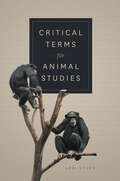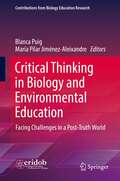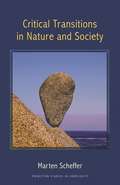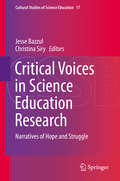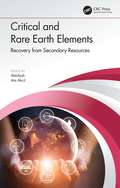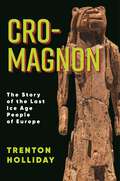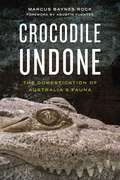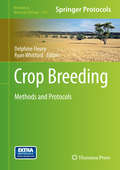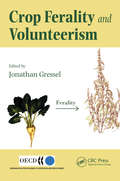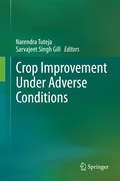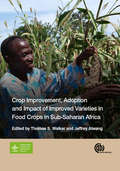- Table View
- List View
Critical States at Phase Transitions of Pure Substances
by Beycan İbrahimoğlu Beycan Jr. İbrahimoğluThis book re-examines the conventional pressure-temperature phase diagrams of pure substances, taking into account a universally acknowledged, albeit often neglected, state of matter—the plasma phase. It argues that only the temperature component of the endpoint on the gas-liquid equilibrium curve is critical, not the pressure and volume, which themselves are the corresponding components of the critical temperature. The book features the compiled results of many recent experimental studies on the physical properties of benzene, hydrogen, and carbon dioxide, extracting the endpoints of the liquid-solid and solid-gas equilibria and yielding the real critical pressure and volume. These discoveries highlight the position of plasma on the phase diagram and the existence of the equilibrium ionization curve along with it. Detailed knowledge of the plasma state of matter is essential not only in many fields of physics and chemistry but in engineering and industrial applications as well. This book will easily benefit researchers, engineers, and instructors who routinely interact with phase diagrams.
Critical Terms for Animal Studies (Critical Terms)
by Lori GruenAnimal Studies is a rapidly growing interdisciplinary field devoted to examining, understanding, and critically evaluating the complex relationships between humans and other animals. Scholarship in Animal Studies draws on a variety of methodologies to explore these multi-faceted relationships in order to help us understand the ways in which other animals figure in our lives and we in theirs. Bringing together the work of a group of internationally distinguished scholars, the contribution in Critical Terms for Animal Studies offers distinct voices and diverse perspectives, exploring significant concepts and asking important questions. How do we take non-human animals seriously, not simply as metaphors for human endeavors, but as subjects themselves? What do we mean by anthropocentrism, captivity, empathy, sanctuary, and vulnerability, and what work do these and other critical terms do in Animal Studies? Sure to become an indispensable reference for the field, Critical Terms for Animal Studies not only provides a framework for thinking about animals as subjects of their own experiences, but also serves as a touchstone to help us think differently about our conceptions of what it means to be human, and the impact human activities have on the more than human world.
Critical Thinking In Psychology: Separating Sense From Nonsense
by John RuscioDo your students have the tools to distinguish between the true science of human thought and behavior from pop psychology? John Ruscio's book provides a tangible and compelling framework for making that distinction. Because we are inundated with "scientific" claims, the author does not merely differentiate science and pseudoscience, but goes further to teach the fundamentals of scientific reasoning on which students can base their evaluation of information.
Critical Thinking for Medical and Graduate Students
by Jonathan M. Berman Troy Camarata Tony A. SliemanThe definitive handbook on critical thinking for medical and graduate students in biomedical sciences.First-year medical and graduate students in biomedical sciences face a variety of challenges in learning to study, feeling as though they belong, and learning to adopt the intellectual habits of their chosen profession. Crucial to their success in this key career period is learning critical thinking, which involves slowing down, as well as considering causality, epistemology, ethics, and one&’s own cognitive biases. This book addresses these challenges by teaching evidence-based study habits, &“the hidden curriculum,&” and how to think about complex topics in biomedicine, especially for underrepresented students.With a wealth of practical examples and case studies, this accessibly written book presents complex topics from a variety of fields such as philosophy and logic in a digestible format for the target audience.
Critical Thinking in Biology and Environmental Education: Facing Challenges in a Post-Truth World (Contributions from Biology Education Research)
by Blanca Puig María Pilar Jiménez-AleixandreThis volume seeks to broaden current ideas about the role of critical thinking (CT) in biology and environmental education considering educational challenges in the post-truth era. The chapters are distributed into three sections, perspectives of a theoretical character (part I), empirical research about CT in the context of biology and health education (part II), and empirical research on CT in the context of environmental and sustainability education (part III). The volume includes studies reporting students’ engagement in the practice of critical thinking, and displays how CT can be integrated in biology and environmental education and why biology and environmental issues are privileged contexts for the development of CT. The chapters examine a range of dimensions of CT, such as skills, dispositions, emotions, agency, open-mindedness, or personal epistemologies. In addition, they explore topics such as climate change, sustainable diets, genetically modified food, vaccination, acceptance of evolution, homeopathy, and gene cloning. Concluding remarks regarding the connections between the chapters and future directions for the integration of critical thinking in biology and environmental education are presented in a final chapter.
Critical Thinking in Science Education and Teacher Training (Contemporary Trends and Issues in Science Education #2)
by Antonio Joaquín Franco-MariscalThis edited volume explores the challenge of fostering critical thinking (CT) skills in science education, presenting the ENCIC-CT model as a framework for development. Named after the Science Education and Competences (Enseñanza de las Ciencias y Competencias, ENCIC) research group at the University of Malaga, Spain, this model emphasizes cultivating CT through socio-scientific issues and daily-life problems. It includes three key domains: knowledge, skills, and dispositions, each encompassing various dimensions addressed through scientific practices like argumentation, inquiry, and modeling. Teaching strategies such as gamification, role-playing, micro-debates, augmented reality, controversy mapping, and digital storytelling are highlighted. Spanning theoretical perspectives and practical experiences from early childhood to higher education, this book consolidates findings from the Spanish R&D project, “Citizens with Critical Thinking: A Challenge for Teachers in Science Education.” It is an essential resource for educators, researchers, and practitioners, offering valuable insights and practical applications for all educational levels.
Critical Transitions in Nature and Society (Princeton Studies in Complexity #16)
by Marten SchefferHow do we explain the remarkably abrupt changes that sometimes occur in nature and society--and can we predict why and when they happen? This book offers a comprehensive introduction to critical transitions in complex systems--the radical changes that happen at tipping points when thresholds are passed. Marten Scheffer accessibly describes the dynamical systems theory behind critical transitions, covering catastrophe theory, bifurcations, chaos, and more. He gives examples of critical transitions in lakes, oceans, terrestrial ecosystems, climate, evolution, and human societies. And he demonstrates how to deal with these transitions, offering practical guidance on how to predict tipping points, how to prevent "bad" transitions, and how to promote critical transitions that work for us and not against us. Scheffer shows the time is ripe for understanding and managing critical transitions in the vast and complex systems in which we live. This book can also serve as a textbook and includes a detailed appendix with equations.Provides an accessible introduction to dynamical systems theory Covers critical transitions in lakes, oceans, terrestrial ecosystems, the climate, evolution, and human societies Explains how to predict tipping points Offers strategies for preventing "bad" transitions and triggering "good" ones Features an appendix with equations
Critical Transitions in Nature and Society (Princeton Studies in Complexity)
by Marten SchefferHow do we explain the remarkably abrupt changes that sometimes occur in nature and society--and can we predict why and when they happen? This book offers a comprehensive introduction to critical transitions in complex systems--the radical changes that happen at tipping points when thresholds are passed. Marten Scheffer accessibly describes the dynamical systems theory behind critical transitions, covering catastrophe theory, bifurcations, chaos, and more. He gives examples of critical transitions in lakes, oceans, terrestrial ecosystems, climate, evolution, and human societies. And he demonstrates how to deal with these transitions, offering practical guidance on how to predict tipping points, how to prevent "bad" transitions, and how to promote critical transitions that work for us and not against us. Scheffer shows the time is ripe for understanding and managing critical transitions in the vast and complex systems in which we live. This book can also serve as a textbook and includes a detailed appendix with equations.
Critical Voices in Science Education Research: Narratives of Hope and Struggle (Cultural Studies of Science Education #17)
by Jesse Bazzul Christina SiryThis book is a collection of narratives from a diverse array of science education researchers that elucidate some of the difficulties of becoming a science education researcher and/or science teacher educator, with the hope that through solidarity, commonality, and “telling the story”, justice-oriented science education researchers will feel more supported in their own journeys. Being a scholar and teacher that sees science education as a space for justice, and thinking/being different, entry into this disciplinary field often comes with tense moments and personal difficulties. The chapter authors of this book break into many painful, awkward, and seemingly nebulous topics, including the intersectional nuances of what it means to be a researcher in the contexts of epistemic rigidness, white supremacy, and neoliberal restructuring. Of course these contexts become different depending on how teachers, students, and researchers are constituted within them (as racialized/sexed/gendered/disposable/valued subjects). We hope that within these narratives readers will identify with similar struggles in terms of what it means to desire to “do good in the world”, while facing subtle and not-so-subtle institutional, personal cultural, and political challenges.
Critical Zone and Ecosystem Dynamics (Advances in Critical Zone Science)
by Timothy White Antonello ProvenzaleThe critical zone is the thin outer veneer of continental Earth extending from the top of the vegetation canopy to subsurface depths where fresh groundwater circulates. It is the heterogeneous amalgamation of landscapes, ecosystems, and subsurface environments. The concept of the critical zone is relatively new and while thousands of manuscripts have been published from this interdisciplinary field, they exist within a wide array of journals, and none have comprehensively addressed the intersection between the geosciences and ecosystem science—“where rock meets life”. The goal of this contributed book is to promote the great potential that exists in a merger of critical zone and ecosystem science to further scientific discovery by leveraging the strengths of multiple disciplines to address societally relevant questions, keep pace with scientific advances, and more effectively engage with broader scientific communities and the public. The core readership will be collaborative researchers working at the intersection between the greater Earth, environmental and ecological sciences, and policy and business sectors that draw on science evidence to support sustainable economic development. The book also serves further readership that includes scientists from many fields, particularly those in early and mid-career stages who are interested in environmental sustainability and are seeking to step out from disciplinary research into collaborative cross-disciplinary study.
Critical and Rare Earth Elements: Recovery from Secondary Resources
by Abhilash Pillai Ata AkcilThis book is aimed to compile the distribution of rare earth elements in various resources with their processing from secondary resources. It includes details of various processes developed for extraction of rare earth elements from varied raw materials ranging from e-wastes, tailings, process wastes and residues. It emphasizes importance of processing of the secondary resources to assist environmental remediation of such untreated wastes and get finished products. It covers all aspects of rare metals and rare earth metals in one volume covering extraction, separation and recycling of secondary resources for extraction of these metals along with relevant case studies.
Critical, Transdisciplinary and Embodied Approaches in STEM Education (Advances in STEM Education)
by Pratim Sengupta Marie-Claire Shanahan Beaumie KimOver the past decade, integrated STEM education research has emerged as an international concern, creating around it an imperative for technological and disciplinary innovation and a global resurgence of interest in teaching and learning to code at the K-16 levels. At the same time, issues of democratization, equity, power and access, including recent decolonizing efforts in public education, are also beginning to be acknowledged as legitimate issues in STEM education. Taking a reflexive approach to the intersection of these concerns, this book presents a collection of papers making new theoretical advances addressing two broad themes: Transdisciplinary Approaches in STEM Education and Bodies, Hegemony and Decolonization in STEM Education. Within each theme, praxis is of central concern including analyses of teaching and learning that re-imagines disciplinary boundaries and domains, the relationship between Art and STEM, and the design of learning technologies, spaces and environments. In addition to graduate research seminars at the Masters and PhD levels in Learning Sciences, Science Education, Educational Technology and STEM education, this book could also serve as a textbook for graduate and pre-service teacher education courses.
Criticism and the Growth of Knowledge
by Imre Lakatos Alan MusgraveTwo books have been particularly influential in contemporary philosophy of science: Karl R. Popper's Logic of Scientific Discovery, and Thomas S. Kuhn's Structure of Scientific Revolutions. Both agree upon the importance of revolutions in science, but differ about the role of criticism in science's revolutionary growth. This volume arose out of a symposium on Kuhn's work, with Popper in the chair, at an international colloquium held in London in 1965. The book begins with Kuhn's statement of his position followed by seven essays offering criticism and analysis, and finally by Kuhn's reply. The book will interest senior undergraduates and graduate students of the philosophy and history of science, as well as professional philosophers, philosophically inclined scientists, and some psychologists and sociologists.
Critiquing Sustainability, Changing Philosophy (Routledge Studies in Sustainability)
by Jenneth ParkerTo increasing numbers of people, sustainability is the key challenge of the twenty-first century. In the many fields where it is a goal, persistent problems obstruct the efforts of those trying to make a difference. The task of this book is to provide an overview of the current state of philosophy in the context of what philosophy is, could be or should be – in relation to sustainability and the human future on Earth. The book is conceived as a contribution to the UN Decade of Education for Sustainable Development, helping to link work on philosophy and sustainability. Critiquing Sustainability, Changing Philosophy focusses on the importance of philosophical work to the formation and effectiveness of global civil society and social movements for sustainability in the context of the Anthropocene age of the Earth. It takes a transdisciplinary systems approach that challenges philosophy and concludes by proposing a greatly enhanced role for philosophy in contributing to global public reason for sustainability. This book will be of interest to philosophers, sustainability practitioners and thinkers, policy makers and all those engaged in the global movement for sustainability.
Crittercam
by Andrew EinspruchThis book is all about Crittercams and how these scientists use them to study everything the animal does.
Cro-Magnon: The Story of the Last Ice Age People of Europe
by Trenton W. HollidayDuring the Last Ice Age, Europe was a cold, dry place teeming with mammoths, woolly rhinoceroses, reindeer, bison, cave bears, cave hyenas, and cave lions. It was also the home of people physically indistinguishable from humans today, commonly known as the Cro-Magnons. Our knowledge of them comes from either their skeletons or the tools, art, and debris they left behind.This book tells the story of these dynamic and resilient people in light of recent scientific advances. Trenton Holliday—a paleoanthropologist who has studied the Cro-Magnons for decades—explores questions such as: Where and when did anatomically modern humans first emerge? When did they reach Europe, and via what routes? How extensive or frequent were their interactions with Neandertals? What did Cro-Magnons look like? What did they eat, and how did they acquire their food? What can we learn about their lives from studying their skeletons? How did they deal with the glacial cold? What does their art tell us about them?Holliday offers new insights into these ancient people from anthropological, archaeological, genetic, and geological perspectives. He also considers how the Cro-Magnons responded to Earth’s postglacial warming almost 12,000 years ago, showing that how they dealt with climate change holds valuable lessons for us as we negotiate life on a rapidly warming planet.
Crocodile Undone: The Domestication of Australia’s Fauna (Animalibus)
by Marcus Baynes-RockAcross the world, animals are being domesticated at an unprecedented rate and scale. But what exactly is domestication, and what does it tell us about ourselves? In this book, Marcus Baynes-Rock seeks the common thread linking stories about the domestication of Australia's native animals, arguing that domestication is part of a process by which late modernity threatens to undo the world.In a deeply personal account, the author tells of his encounters with crocodiles and emus behind fences, dingoes and kangaroos crossing boundaries, and native bees producing honey in his suburban backyard. Drawing on comparisons between Aboriginal and colonial Australians, Baynes-Rock reveals how the domestication of Australia’s fauna is a process of “unmaking.” As an extension of late modernity, the connections that tie humans and other animals to wider ecologies are being severed, threatening to isolate us and our domesticates from the rest of the world. It is here that Baynes-Rock reveals a key difference between Aboriginal and colonial Australian modes of landscape management: while one is focused on a systemic approach and sees humans as integral to ecological integrity, the other seeks to sever domesticates from ecological processes. The question that emerges is: How might we reconfigure and maintain these connections without undoing humanity?Written in the author’s characteristically frank, passionate, and humorous style, Crocodile Undone takes the reader on a journey across both physical and philosophical landscapes. This fascinating narrative will appeal to anyone interested in the vital connections between humans and animals.
Crocodile Undone: The Domestication of Australia’s Fauna (Animalibus: Of Animals and Cultures #15)
by Marcus Baynes-RockAcross the world, animals are being domesticated at an unprecedented rate and scale. But what exactly is domestication, and what does it tell us about ourselves? In this book, Marcus Baynes-Rock seeks the common thread linking stories about the domestication of Australia's native animals, arguing that domestication is part of a process by which late modernity threatens to undo the world.In a deeply personal account, the author tells of his encounters with crocodiles and emus behind fences, dingoes and kangaroos crossing boundaries, and native bees producing honey in his suburban backyard. Drawing on comparisons between Aboriginal and colonial Australians, Baynes-Rock reveals how the domestication of Australia’s fauna is a process of "unmaking." As an extension of late modernity, the connections that tie humans and other animals to wider ecologies are being severed, threatening to isolate us and our domesticates from the rest of the world. It is here that Baynes-Rock reveals a key difference between Aboriginal and colonial Australian modes of landscape management: while one is focused on a systemic approach and sees humans as integral to ecological integrity, the other seeks to sever domesticates from ecological processes. The question that emerges is: How might we reconfigure and maintain these connections without undoing humanity?Written in the author’s characteristically frank, passionate, and humorous style, Crocodile Undone takes the reader on a journey across both physical and philosophical landscapes. This fascinating narrative will appeal to anyone interested in the vital connections between humans and animals.
Crop Breeding: Methods and Protocols (Methods in Molecular Biology #1145)
by Delphine Fleury Ryan WhitfordThe recent advent of molecular technologies has changed the way plant breeders identify and select their germplasm as genetic variation can now be assessed at the DNA level. Crop Breeding: Methods and Protocols presents detailed guidelines and tutorials that suit different needs and capacity from small laboratories analyzing molecular markers on a one-by-one basis to the increasingly popular high-throughput protocols for high capacity laboratories. Topics covered include breeding strategy for the selection of an ideal variety or genetic ideo type, protocols for breeders using molecular markers in selection programs and for laboratories providing molecular services to breeding programs, statistical programs and software to aid implementation of molecular data into breeding programs and methodologies that facilitate the generation of genetic diversity and its characterization. Written in the successful Methods in Molecular Biology series format, chapters include introductions to their respective topics, lists of the necessary materials and reagents, step-by-step, readily reproducible protocols and notes on troubleshooting and avoiding known pitfalls. Authoritative and easily accessible, Crop Breeding: Methods and Protocols will help in expanding the use of molecular technologies for the creation of tomorrow's crop varieties.
Crop Ferality and Volunteerism
by Jonathan GresselAt a time when much of humanity is already but one failed harvest removed from starvation, we cannot afford to ignore any potential danger to food security, especially when that danger poses a threat to rice, the staff of life for so much of the world. Crop Ferality and Volunteerism brings together research pioneers from various disciplines
Crop Genetic Diversity in the Field and on the Farm
by Devra I. Jarvis Anthony H. Brown Toby HodgkinBased on twenty years of global research, this is the first comprehensive reference on crop genetic diversity as it is maintained on farmland around the world. Showcasing the findings of seven experts representing the fields of ecology, crop breeding, genetics, anthropology, economics, and policy, this invaluable resource places farmer-managed crop biodiversity squarely in the center of the science needed to feed the world and restore health to our productive landscapes. It will prove to be an essential tool in the training of agricultural and environmental scientists seeking the solutions necessary to ensure healthy, resilient ecosystems for future generations.
Crop Improvement Under Adverse Conditions
by Sarvajeet Singh Gill Narendra TutejaPlant development and productivity are negatively regulated by various environmental stresses. Abiotic stress factors such as heat, cold, drought, and salinity represent key elements limiting agricultural productivity worldwide. Thus, developing crop plants with the ability to tolerate abiotic stresses is a critical need which demands modern novel strategies for the thorough understanding of plant response to abiotic stresses. Crop Improvement under Adverse Conditions will serve as a cutting-edge resource for researchers and students alike who are studying plant abiotic stress tolerance and crop improvement. The book presents the latest trends and developments in the field, including the impact of extreme events on salt tolerant forest species of Andaman & Nicobar Islands, the overlapping horizons of salicylic acid in different stresses, and fast and reliable approaches to crop improvement through In Vitro haploid production. Written by renowned experts and featuring useful illustrations and photographs, Crop Improvement under Adverse Conditions is a concise and practical update on plant abiotic stress tolerance and crop improvement.
Crop Improvement Utilizing Biotechnology
by Rup LalThis book discusses; somaclonal variation in crop improvement, the role of tissue culture in rapid clonal propagation and production of pathogen-free plant, protoplasts in crop improvement, cell selection and long-term high-frequency regeneration of cereals and legumes, agrobacteria-mediated gene transformation and vectors for gene cloning in plants, and plant frost injury and its management.
Crop Improvement, Adoption and Impact of Improved Varieties in Food Crops in Sub-Saharan Africa
by Jeffrey Alwang Dr Thomas S. WalkerFollowing on from the CGIAR study by Evenson and Gollin (published by CABI in 2003), this volume provides up-to-date estimates of adoption outcomes and productivity impacts of crop variety improvement research in sub-Saharan Africa. The book reports on the results of the DIIVA Project that focussed on the varietal generation, adoption and impact for 20 food crops in 30 countries. It also compares adoption outcomes in sub-Saharan Africa to those in South Asia, and guides future efforts for global agricultural research
Crop Improvement, Adoption and Impact of Improved Varieties in Food Crops in Sub-Saharan Africa
by Jeffrey Alwang Thomas S. WalkerFollowing on from the CGIAR study by Evenson and Gollin (published by CABI in 2003), this volume provides up-to-date estimates of adoption outcomes and productivity impacts of crop variety improvement research in sub-Saharan Africa. The book reports on the results of the DIIVA Project that focussed on the varietal generation, adoption and impact for 20 food crops in 30 countries. It also compares adoption outcomes in sub-Saharan Africa to those in South Asia, and guides future efforts for global agricultural research

